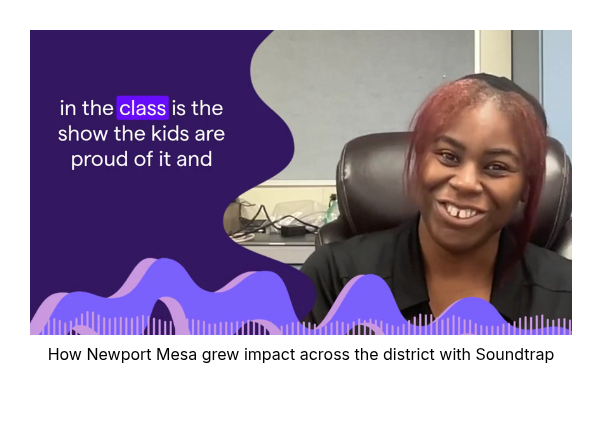
How Newport Mesa Turned 6th Grade Music Into a Bridge for Every Learner
September 25, 2025A district-wide transformation story: From traditional performance-focused classes to digital music creation that engages every student and builds career-ready skills
District Snapshot and the Core Problem
Newport Mesa Unified School District sits between two California cities – Costa Mesa and Newport Beach – serving 22 elementary schools and seven high schools. Like many districts coming out of the pandemic, they faced a familiar challenge: how to reach students who weren’t connecting with traditional classroom approaches.
“We bought seats specifically for our sixth graders,” explains Tamara Fairbanks, Arts TOSA for Newport Mesa. “We wanted to create that bridge – something unique that is middle school level and unit-based.”
The district’s sixth graders remain at the elementary level rather than moving to middle school, creating a unique opportunity. But Fairbanks and her team recognized that their instrumental education programs, while strong, were still missing students.
“Coming out of the pandemic, we realized that yes, our instrumental education was great, but there was still kids missing out. We felt that digital music creation would be a great tool to engage those students we kept missing.”
Newport Mesa serves students across a wide demographic spectrum – from the west side of Costa Mesa to Newport Coast – representing diverse socioeconomic and ethnic backgrounds. The challenge was finding tools that worked for everyone, on their existing 1:1 Chromebook infrastructure, without adding burden to teachers already managing complex curriculum demands.
The Turning Point
The moment everything changed came during a classroom observation. Fairbanks was watching one of her newer teachers facilitate a digital music creation project when she witnessed something that transformed her perspective on what these tools could accomplish.
“The special needs kids who were standoffish when it came to instrumental instruction were completely all in when it came to Soundtrap,” she recalls. “They were not only creating their own sounds and their own mixes of songs, they were actually analyzing each other’s music and engaging with students one-to-one.”
She watched as students offered specific feedback: “I like that drumbeat. What drumbeat is that so I can incorporate that?” The interaction between special ed and general education students revealed a level of peer collaboration that hadn’t emerged in traditional instrumental settings.
“That interaction between my special ed students and my gen ed students really sold me. We didn’t have to encourage kids with Soundtrap. They were just all in.”
The icing on the cake came when students continued working at home. Because Newport Mesa provides 1:1 Chromebooks, students could share and comment on each other’s work beyond the classroom. “Kids came back and said, ‘Ms. Fairbanks, you have to check out this song I just wrote. I was doing this with my buddies at home.'”
Implementation Journey
From Hodgepodge to a Plan
Before district-wide adoption, Newport Mesa’s approach to music technology in the classroom was scattered. “Teachers would apply for grants here and there for digital materials,” Fairbanks explains. “It was very hodgepodge.”
Three tech-forward music teachers – two at secondary level and one elementary – completed training with Shed The Music and fell in love with the music creation possibilities. Tim McFadden, who moved from middle school to elementary general music, specifically wanted to keep using digital creation tools with his younger students.
“Tim used to teach at the middle school level and wanted to keep Soundtrap for his kids when he moved to elementary,” Fairbanks says. “I completely supported that and said, ‘Actually, we really should do it for all of our sixth graders.'”
Curriculum and Pilots
Rather than relying entirely on external curriculum, Newport Mesa created their own materials while piloting Shed The Music to evaluate district-wide adoption. This approach allows them to test what works across their diverse student population while maintaining flexibility.
“We’re doing a pilot with Shed The Music this year to see if our district can adopt it,” Fairbanks notes. “We have a huge demographic of students, so we need to see what works for everyone.”
Change Management
Implementation wasn’t without challenges. “When we first started, I had half of my staff gung-ho and the other half was kind of hesitant,” Fairbanks admits. Some teachers questioned whether students should be on devices for music class, worried about replacing traditional instruction.
But systematic training and peer sharing shifted attitudes. “The more training, the more familiarity, the more utilization,” she explains. “When everyone started sharing their best practices and how easy they were to do in class, the hesitant teachers thought, ‘Oh, I guess I can do this.'”
Once teachers saw student reactions – the excitement and engagement – they were convinced. “Now we have winners, and they’re all in.”
Outcomes That Matter
Engagement and Inclusion
The transformation in student engagement was immediate and sustained. Students who struggled with traditional formats found their voice through digital creation. The cloud-based collaboration meant learning continued seamlessly between classroom and home on their Chromebooks.
“It speaks to their language,” Fairbanks observes. “When they listen to popular music now, they’re like, ‘Oh, I hear that. I hear that guitar riff.’ There’s that personal connection with whatever genre they listen to.”
Better Instrumental Participation
Rather than replacing traditional music education, digital creation enhanced it. “Teachers actually see better instrumental engagement because the kids know Soundtrap,” Fairbanks explains. “They will record themselves on their own instruments. It actually reinforces what they’re already doing in their instrumental unit.”
Students bring both analog and digital skills together – recording their clarinet playing while creating full compositions around it, or building rock band arrangements using the digital tools they’ve mastered.
Process Over Performance
Perhaps the most significant shift was moving from performance-focused assessment to process-centered learning. “A lot of our focus was on having a show,” Fairbanks reflects. “Whereas while we’re incorporating Soundtrap, whatever we do in class is the show.”
This change liberated both students and teachers from the pressure of polished final products. Instead, every creation – “whether it’s a two-second song or whatever” – becomes publishable. Students take pride in their development rather than worrying about perfection.
“The focus on development is helpful to my teachers, to really think about the skills and the process of creating music versus the end performance.”
Transfer Across Subjects
The most surprising outcome was students independently applying their audio creation skills in other classes. Without structural encouragement, sixth graders began using the platform for history projects and mini-podcasts.
“I discovered through several sixth grade teachers that kids are utilizing Soundtrap on their own for walkthroughs of ancient times,” Fairbanks shares. “The kids are spearheading it, and it’s just flowing from what’s happening in the music classroom.”
Classroom teachers noticed and were excited about the cross-curricular applications their students were discovering.
What Students Actually Become
The most profound change wasn’t just in engagement – it was in how students approached listening and critique. Digital music creation developed analytical skills that transferred far beyond the music classroom.
“One of the things Soundtrap does is strengthen listening skills,” Fairbanks explains. “Kids are actually listening to music at a deeper level because of the process they’re utilizing.”
Instead of vague feedback like “I don’t like that,” students learned to articulate specific critiques: “I feel like the drums are overpowering the guitar. What would you do instead?”
This precision in analysis created stronger critical thinking abilities. “Even when they go to live performances now, some of the kids will say, ‘Hey, I just heard that guitar riff somewhere.’ I can tell they’re really listening in detail.”
The Universal Design for Learning principles embedded in this approach meant every student could demonstrate their understanding through their preferred modality.
Advice to District Leaders
Advocate Across Subjects
For district leaders considering similar initiatives, Fairbanks emphasizes the cross-curricular value: “It’s not just a music app. It’s an expressive tool that can be utilized in all subject matters.”
The platform transcends traditional subject boundaries. “It’s a great tool for the classroom teacher, for the music teacher, for the history teacher. The creative process helps kids critically think, analyze, and synthesize in all subject matters.”
Start With 6th Grade as a Bridge
Newport Mesa’s approach of focusing on sixth grade created a natural transition point. “Bridge is my word,” Fairbanks says when asked to sum up the impact. “It’s a bridge between that elementary mindset to a more secondary mindset, from traditional instrumental to digital, from performance to critical thinking and creativity.”
This capstone approach gives students advanced tools while maintaining elementary-level support structures.
Train, Share, Repeat
Successful implementation requires consistent professional development and peer sharing. “Regular training, familiarity, and sharing best practices” converted hesitant teachers into advocates.
The key was showing practical classroom applications rather than focusing on technical features. When teachers saw easy wins and student excitement, adoption became natural.
Career Readiness, Right Now
While creativity and critical thinking matter, Fairbanks also emphasizes the immediate career pathways digital music creation opens for students. “I talk to my arts partners all the time – sound techs, engineers, even within our churches, you need that creative person to mix sounds, to create sounds.”
These aren’t distant future possibilities. “They can have apprenticeships even in high school utilizing these tools. I have yet to find a starving artist when it comes to my sound people. Sound people are always needed.”
The 21st Century Skills students develop – collaboration, creativity, critical thinking, and communication – align directly with workforce demands across industries.
One Word That Sums It Up
“Bridge,” Fairbanks says without hesitation. “We’ve been trying to figure out how to better engage our sixth grade students, that middle school level kid whose minds are all over the place. It’s a bridge between elementary mindset to secondary mindset, from traditional instrumental to digital, from performance to critical thinking and creativity.”
That bridge metaphor captures something essential about what happens when students find tools that speak their language while building the skills educators prioritize. It’s not about choosing between traditional and digital approaches – it’s about creating pathways that honor both while preparing students for futures that will require creative problem-solving, collaborative skills, and comfort with technology.
The Real Impact
Newport Mesa’s story illustrates what becomes possible when districts move beyond thinking of creative tools as “nice-to-have” additions. By positioning digital music creation as a core component of sixth grade curriculum, they created space for students to demonstrate learning in ways that work for them.
“Students really need various ways to work on analytical processes,” Fairbanks reflects. “When they have the means to think critically and create, they make amazing things. All we need to do is facilitate that creative spark.”
The results speak for themselves: increased engagement across ability levels, stronger instrumental participation, transfer of skills to other subjects, and student-driven innovation that surprised even experienced educators.
“Whatever we do in class is the show,” Fairbanks emphasizes. In a world focused on high-stakes testing and performance pressure, that shift toward celebrating development over demonstration creates the psychological safety students need to take creative risks and discover what they’re capable of creating.
For district leaders weighing similar investments, Newport Mesa’s experience suggests that the question isn’t whether creative technology tools are worth it – it’s whether districts can afford to miss the opportunity to give every student a voice and the skills to use it effectively.
Interested in seeing how digital music creation could work in your district? Request a district demo to explore curriculum-aligned solutions that amplify student voice while building critical thinking, literacy, and collaboration skills across all subjects.
 EDU Portal
EDU Portal



